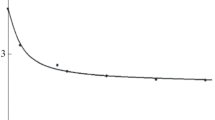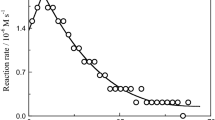Abstract
Two complexes, [Cr(3-hpic){3}]{0} and [Cr(2-hnic){3}]{0} (where 3-hpic = hydroxypicolinic acid and 2-hnic = 2-hydroxynicotinic acid anions), were prepared and characterized in solution. The 3-hpic ligand forms a 5-membered chelate ring via pyridine nitrogen and carboxlate oxygen atoms, whereas the 2-hnic ligand forms a 6-membered chelate ring via carboxylate and phenolate oxygen atoms. The kinetics of the acid-catalyzed aquation were studied spectrophotometrically in the 0.1–1.0 HClO{4} range, at I = 1.0 . The rate equations for the first aquation step – the chelate-ring opening – was determined and a mechanism was proposed. In the case of [Cr(3-hpic){3}]{0}, the reversible chelate-ring opening at the Cr—N bond precedes much slower than the second aquation step – a one-end bonded ligand liberation. The equation rate is of the form: k {obs} = k {1} + k {-1} /Q {1}[H{+}], where k {1} and k {-1} are the rate constants for the forward and the reverse processes in the unprotonated substrate and Q {1} is the protonation constant of the non-bonded pyridine nitrogen atom. In the case of [Cr(2-hnic)3]{0}, the chelate-ring opening at the Cr—O (phenolate) bond is the rate-determining step. The observed pseudo-first order rate constant increases as [H{+}] increases: k {obs} = k {0} + k {H} Q {H}[H{+}], where k {0} and k {H} are the rate constants of the spontaneous and acid catalyzed processes and Q {H} is the protonation constant of the coordinated phenolate oxygen atom. The results lead to the conclusion that an aquation mechanism depends on the coordination mode of the ligand.
Similar content being viewed by others
References
G.W. Evans and T.D. Bowman, J. Inorg. Biochem., 46, 243 (1992).
J.B. Vincent, Polyhedron, 20, 1 (2001).
D.D.D. Hepburn, J.M. Burney, S.A. Woski and J.B. Vincent, Polyhedron, 22, 455 (2003).
D.D.D. Hepburn and J.B. Vincent, J. Inorg. Biochem., 94, 86 (2003).
K.W.S. Ashley and C. Orvig, Inorg. Chim. Acta, 273, 47 (1998).
E. Kiss, K. Petrohan, D. Sanna, E. Garribba, G. Micera and T. Kiss, Polyhedron, 19, 55 (2000).
B. Galeffi and A.S. Tracey, Inorg. Chem., 28, 1726 (1989).
K.A. Idriss, M.S. Saleh, H.A. Azab and E.Y. Hashem, Bull. Pol. Acad. Sci. Chem., 43, 67 (1995).
S. Gatto, T.I.A. Gerber, G. Banndoli, J. Perils and J.G.H. du Preez, Inorg. Chim. Acta, 269, 235 (1998).
E. Kita and M. Szabłowicz, Transition Met. Chem., 28, 698 (2003).
G.H. Purses and E.L. King, Inorg. Chem., 26, 392 (1987).
K. Nakamoto and A.E. Martell, J. Am. Chem. Soc., 81, 5857 (1959).
E. Kita and M. Łaçzna, Transition Met. Chem., 26, 510 (2001).
K. Bauer, H. Elies, R. Gaubatz and G. Lang, Inorg. Chim. Acta, 36, 55 (1979).
Author information
Authors and Affiliations
Rights and permissions
About this article
Cite this article
Szabłowicz, M., Kita, E. Kinetics and mechanism of aquation of chromium(III) complexes with 3-hydroxypicolinic and 2-hydroxynicotinic acids in HClO{4{ solutions. Transition Metal Chemistry 29, 762–768 (2004). https://doi.org/10.1007/s11243-004-9115-0
Issue Date:
DOI: https://doi.org/10.1007/s11243-004-9115-0




